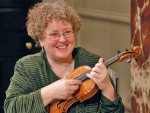Title
“Sometimes I wish I had been Eric Clapton,” the esteemed Baroque violinist Monica Huggett exclaimed during a master class in Juilliard’s Room 335 on February 19. Although Ms. Huggett was joking, the statement revealed her keen sense of humor and offered insights into her philosophy regarding the performance of Baroque music.
Body
While studying modern violin at the Royal Academy of Music in London, her hometown, she discovered the freedom of expression afforded by the recent revival of Baroque music. Ms. Huggett pursued this passion by becoming the leader of the Amsterdam Baroque Orchestra in 1980; she later assumed her current position as artistic director of both the Portland Baroque and Irish Baroque Orchestras. According to her biography on the Web site of her ensemble Sonnerie, it was through Baroque performance that she “was able to communicate the sort of visceral power which she envied in rock music.” It was the “visceral power” of Johann Sebastian Bach’s Sonatas and Partitas, BWV 1001-1006, that Ms. Huggett sought to bring to light in performances by Juilliard student violinists Nanae Iwata, Sharon Chang, and Shih-Kai Lin.
Master’s degree candidate Nanae Iwata began the class with an elegant rendition of the Corrente from Bach’s Partita No. 2 in D Minor. Before commenting upon Nanae’s performance, Ms. Huggett gave a brief history of the violin and its techniques. She explained that she uses neither a chin rest, a 19th-century invention, nor a shoulder rest, another fairly recent invention. In place of a shoulder rest, she attaches a rolled-up cloth to her shirt, allowing for a greater range of motion when playing. By displaying her Baroque bow (c. 1710-1720) next to a modern bow, she emphasized the structural difference between them. She later pointed out that fast notes and certain articulations are much easier to execute using a Baroque bow.
Ms. Huggett then returned to Nanae’s performance of the Corrente. Although written for a single violin, the movement comprises two voices. In order to illustrate the difference between the voices, the two violinists played a portion of the movement as a duet; Ms. Huggett played the bass line while Nanae played the treble. The former then played the movement in its original version, showing that one can bring out the bottom line by giving each bass note a little extra time to ring. Nanae incorporated this idea as she began the movement once again, though this time Ms. Huggett stopped her to suggest a “less-refined” approach to the dance movement. She urged Nanae to “be more fierce” in order to convey the character of the music more effectively.
Next, Nanae gave an energetic performance of the first half of Bach’s Ciaconna. The movement begins with a rest, meaning the first chord does not sound until the second beat. As a result, violinists often struggle to imbue the opening passage with the appropriate rhythmic energy. Ms. Huggett offered a solution with the words “play with a flamenco feeling at the beginning.” Nanae implemented her suggestion; the result was a sweeping and stylish performance.
Sharon Chang, a fourth-year undergraduate, followed with a poised and pensive performance of the Grave from Sonata No. 2 in A Minor. Once again concerned with highlighting the emotional content of the music, Ms. Huggett asked Sharon to bring out the tension and release of the harmonies. Exposing her humorous side, Ms. Huggett played the movement while acting out an impromptu dramatic monologue, consisting of phrases such as “I think I’m all right” (uttered during calm harmonies) and “Oh no, I’m not” (stated during restless harmonies). Harmony remained the topic of discussion after Sharon played the Fuga movement of the same sonata. Ms. Huggett suggested that Sharon take longer to play the massive chords because “they are complex harmonies, and you need to give them a bit longer.” The chords need time to resonate, and the audience needs time to absorb them, she said.
Shih-Kai Lin concluded the master class with his noble presentation of the second half of the Ciaconna. Once again, Ms. Huggett emphasized the importance of taking enough time to allow the harmonies to speak. She also commented on a perfect fifth double stop, explaining that Baroque violinists would add a trill to prevent its sounding hollow.
After the students finished, members of the audience had the opportunity to ask questions. Ms. Huggett imparted advice on a range of topics, including vibrato, ornamentation, and tempo fluctuations. She advised violinists to vibrate where singers would, and to examine Bach’s adagio movements to gain ideas for appropriate ornamentation. Within 90 minutes, Ms. Huggett had offered an enlightening and thoroughly enjoyable master class that urged performers to consider music’s communicative power.





